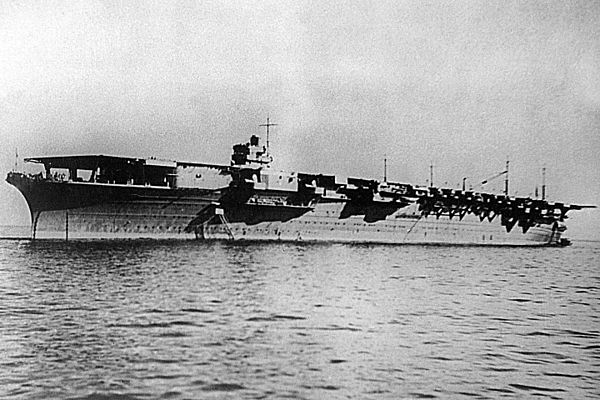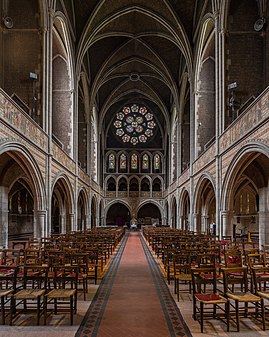Wikipedia:Wikipedia Signpost/2015-12-09/Featured content
Appearance
Featured content
Sports, ships, arts ... and some other things

This Signpost "Featured content" report covers material promoted from 29 November to 5 December.
Text may be adapted from the respective articles and lists; see their page histories for attribution.
Text may be adapted from the respective articles and lists; see their page histories for attribution.
Featured articles



Eight featured articles were promoted this week.
- The 2006 Subway 500 (nominated by Z105space) was the thirty-second stock car race of the 2006 NASCAR Nextel Cup Series and the sixth in the ten-race season-ending Chase for the Nextel Cup. It was held on October 22, 2006 at Martinsville Speedway in Martinsville, Virginia, before a crowd of 65,000. The 500-lap race was won by Jimmie Johnson of the Hendrick Motorsports team, after he started from ninth position; Denny Hamlin finished second, and Bobby Labonte came in third.
- The 2015 Vuelta a España (nominated by Relentlessly) was a three-week Grand Tour cycling race and the 70th edition of the competition. It took place principally in Spain, although two stages took place partly or wholly in Andorra, and was the 22nd race in the 2015 UCI World Tour. The 3,358.1-kilometre (2,086.6 mi) race included 21 stages, beginning in Marbella on 22 August and finishing in Madrid on 13 September.
- The Shōkaku-class aircraft carriers (nominated by Sturmvogel 66) were built for the Imperial Japanese Navy in the late 1930s, and completed shortly before the start of the Pacific War in 1941. With the exception of the Battle of Midway, they participated in every major naval action of the Pacific War. Both members of the class, Shōkaku and Zuikaku, sunk in 1944.
- The Battle of Kalavrye (nominated by Cplakidas) was fought in 1078 between the Byzantine imperial forces led by Alexios Komnenos and the rebellious governor of Dyrrhachium, Nikephoros Bryennios the Elder. The two armies clashed at Kalavrye. Komnenos, whose army was considerably smaller and far less experienced, tried to ambush Bryennios's army. The ambush failed, and the wings of his own army were driven back by the rebels. Alexios himself barely managed to break through with his personal retinue, but succeeded in regrouping his scattered men. At the same time Bryennios's army fell into disorder after its own Pecheneg allies attacked its camp. Reinforced by Turkish mercenaries, Alexios lured the troops of Bryennios into another ambush through a feigned retreat. The rebel army broke, and Bryennios himself was captured.
- Britomart Redeems Faire Amoret (nominated by Iridescent) is an oil painting on canvas by English artist William Etty, now held in Tate Britain. Intended to illustrate the virtues of honour and chastity, it depicts a scene from Edmund Spenser's The Faerie Queene in which the female warrior Britomart slays the evil magician Busirane and frees his captive, the beautiful Amoret. Despite being a depiction of an occult ritual, a violent death, a near-nude woman and strongly implied sexual torture, Britomart Redeems Faire Amoret was uncontroversial on its first exhibition in 1833 and was critically well received.
- Vampire: The Masquerade – Bloodlines (nominated by Darkwarriorblake) is a 2004 action role-playing video game developed by Troika Games and released by Activision. Set in White Wolf Publishing's World of Darkness, the game is based on White Wolf's role-playing game Vampire: The Masquerade and follows either a male or female character who is killed and subsequently revived as a fledgling vampire. The game depicts the fledgling's journey through 21st-century Los Angeles to uncover the truth behind a recently discovered relic that heralds the end of all vampires.
- Sheshi (nominated by Iry-Hor) was a ruler of Egyptian areas during the Second Intermediate Period. The dynasty, chronological position, duration and extent of his reign are uncertain and subject to ongoing debate. The difficulty of identification is mirrored by problems in determining events from the end of the Middle Kingdom to the arrival of the Hyksos. Nonetheless, Sheshi is, in terms of the number of artefacts attributed to him, the best attested king of the period spanning the end of the Middle Kingdom and the Second Intermediate period; roughly from 1800 BC until 1550 BC.
- SMS Kaiser Barbarossa (nominated by Parsecboy) was a German pre-dreadnought battleship of the Kaiser Friedrich III class. The ship was built for the Kaiserliche Marine, and was constructed at Schichau in Danzig. The ship was armed with a main battery of four 24-centimeter (9.4 in) guns in two twin gun turrets. She served with the German navy from her commissioning in 1901, though her active career was limited by two lengthy stays in dry-dock. She was decommissioned in 1909 and placed in the reserve division. Following the outbreak of World War I, Kaiser Barbarossa was mobilized as a coastal defense ship, but she saw no combat during the war, and due to a shortage of crew, the ship was withdrawn from active duty in 1915 and relegated to secondary duties (first as a torpedo target ship and later as a prison ship). Following the end of the war in 1918, Kaiser Barbarossa was decommissioned and sold for scrap metal. The ship was broken up in 1919–20.
Featured lists
Two featured lists were promoted this week.
- Lionel Barrymore on stage, screen and radio (nominated by SchroCat) Lionel Barrymore (1878–1954) was an American actor of stage, screen and radio. He also directed several films, wrote scripts and composed music. He began his film career in 1911, appearing in numerous silent films, before appearing as a character actor in short film in 1912, and moving into feature-length productions in 1914. Barrymore began writing scripts and directing films shortly afterwards. Although he had several successes on Broadway, after he encountered strongly negative criticism of three 1925 productions in a row, he never again appeared on stage. Despite breaking his hip in 1938, Barrymore continued to act in films until 1953.
- Natalie Portman filmography (nominated by Cowlibob) Natalie Portman (born 1981) is an actress, producer, and director with American and Israeli citizenship, who has appeared in 41 films, five television episodes and two documentaries. Portman made her film debut in Léon: The Professional, where she starred as a vengeful child assassin, but gained international recognition by portraying Padmé Amidala in Star Wars Episode I: The Phantom Menace.
Featured pictures
Thirteen featured pictures were promoted this week.















Discuss this story